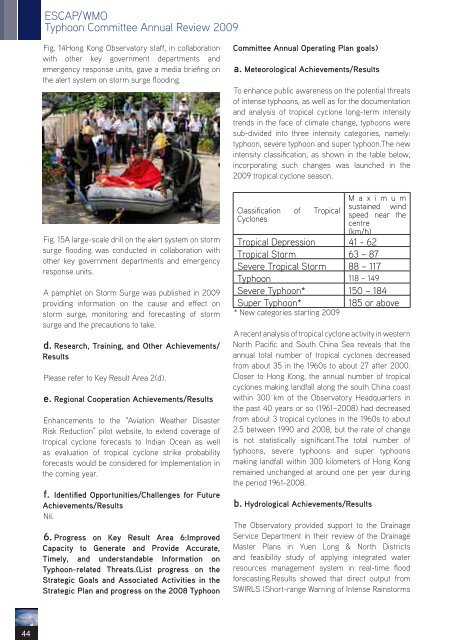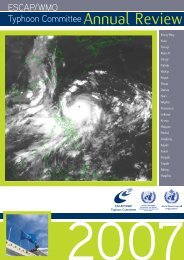TCAR - Typhoon Committee
TCAR - Typhoon Committee
TCAR - Typhoon Committee
Create successful ePaper yourself
Turn your PDF publications into a flip-book with our unique Google optimized e-Paper software.
44<br />
ESCAP/WMO<br />
<strong>Typhoon</strong> <strong>Committee</strong> Annual Review 2009<br />
Fig. 14Hong Kong Observatory staff, in collaboration<br />
with other key government departments and<br />
emergency response units, gave a media briefing on<br />
the alert system on storm surge flooding.<br />
Fig. 15A large-scale drill on the alert system on storm<br />
surge flooding was conducted in collaboration with<br />
other key government departments and emergency<br />
response units.<br />
A pamphlet on Storm Surge was published in 2009<br />
providing information on the cause and effect on<br />
storm surge, monitoring and forecasting of storm<br />
surge and the precautions to take.<br />
d. Research, Training, and Other Achievements/<br />
Results<br />
Please refer to Key Result Area 2(d).<br />
e. Regional Cooperation Achievements/Results<br />
Enhancements to the “Aviation Weather Disaster<br />
Risk Reduction” pilot website, to extend coverage of<br />
tropical cyclone forecasts to Indian Ocean as well<br />
as evaluation of tropical cyclone strike probability<br />
forecasts would be considered for implementation in<br />
the coming year.<br />
f. Identified Opportunities/Challenges for Future<br />
Achievements/Results<br />
Nil.<br />
6. Progress on Key Result Area 6:Improved<br />
Capacity to Generate and Provide Accurate,<br />
Timely, and understandable Information on<br />
<strong>Typhoon</strong>-related Threats.(List progress on the<br />
Strategic Goals and Associated Activities in the<br />
Strategic Plan and progress on the 2008 <strong>Typhoon</strong><br />
<strong>Committee</strong> Annual Operating Plan goals)<br />
a. Meteorological Achievements/Results<br />
To enhance public awareness on the potential threats<br />
of intense typhoons, as well as for the documentation<br />
and analysis of tropical cyclone long-term intensity<br />
trends in the face of climate change, typhoons were<br />
sub-divided into three intensity categories, namely:<br />
typhoon, severe typhoon and super typhoon.The new<br />
intensity classification, as shown in the table below,<br />
incorporating such changes was launched in the<br />
2009 tropical cyclone season.<br />
Classification of Tropical<br />
Cyclones<br />
M a x i m u m<br />
sustained wind<br />
speed near the<br />
centre<br />
(km/h)<br />
Tropical Depression 41 - 62<br />
Tropical Storm 63 – 87<br />
Severe Tropical Storm 88 – 117<br />
<strong>Typhoon</strong> 118 – 149<br />
Severe <strong>Typhoon</strong>* 150 – 184<br />
Super <strong>Typhoon</strong>* 185 or above<br />
* New categories starting 2009<br />
A recent analysis of tropical cyclone activity in western<br />
North Pacific and South China Sea reveals that the<br />
annual total number of tropical cyclones decreased<br />
from about 35 in the 1960s to about 27 after 2000.<br />
Closer to Hong Kong, the annual number of tropical<br />
cyclones making landfall along the south China coast<br />
within 300 km of the Observatory Headquarters in<br />
the past 40 years or so (1961–2008) had decreased<br />
from about 3 tropical cyclones in the 1960s to about<br />
2.5 between 1990 and 2008, but the rate of change<br />
is not statistically significant.The total number of<br />
typhoons, severe typhoons and super typhoons<br />
making landfall within 300 kilometers of Hong Kong<br />
remained unchanged at around one per year during<br />
the period 1961-2008.<br />
b. Hydrological Achievements/Results<br />
The Observatory provided support to the Drainage<br />
Service Department in their review of the Drainage<br />
Master Plans in Yuen Long & North Districts<br />
and feasibility study of applying integrated water<br />
resources management system in real-time flood<br />
forecasting.Results showed that direct output from<br />
SWIRLS (Short-range Warning of Intense Rainstorms

















